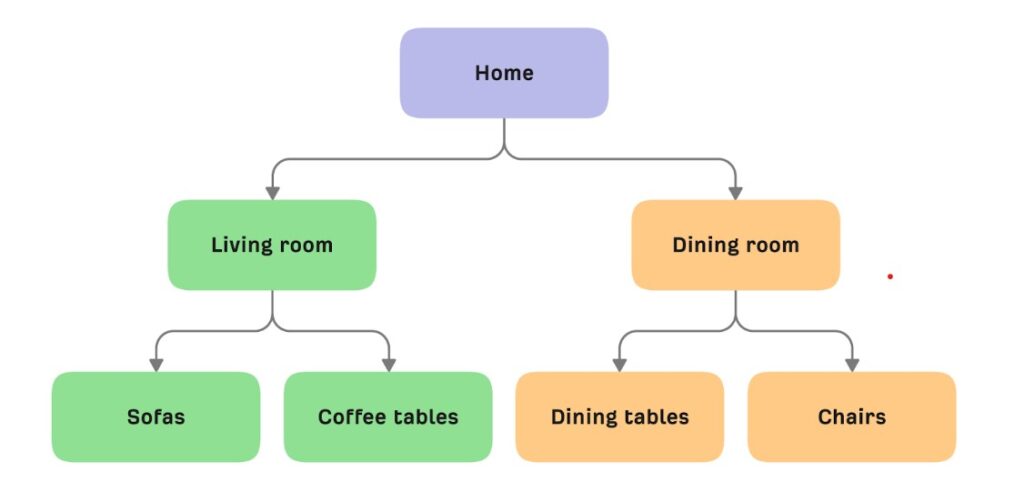In the dynamic landscape of search engine optimization (SEO), website structure plays a pivotal role in determining the visibility and ranking of web pages.
Among the various elements that contribute to an optimized website, the hierarchical structure stands out as a fundamental aspect with profound implications for SEO success.
What is Hierarchical Structure?
In the realm of web development and content organization, a pyramid structure refers to the systematic arrangement of web pages and content in a logical hierarchy or tree-like format.
This structure typically consists of parent and child pages, with parent pages serving as top-level categories and child pages nested within them to represent subcategories or specific topics.
The Role of Hierarchical Structure in SEO:
Clarity and Organization:
A hierarchical structure provides a clear and organized framework for organizing website content. By categorizing content into logical sections and sub-sections, users and search engines can easily navigate through the site and understand the relationships between different pages.
Keyword Relevance:
The hierarchical structure allows website owners to incorporate relevant keywords into the URL hierarchy. Including targeted keywords in the URL can enhance the visibility of web pages in search engine results pages (SERPs) and improve their chances of ranking for relevant search queries.
Improved Indexing and Crawling:
Search engine crawlers utilize the website pyramid structure to navigate and index web pages efficiently. A well-organized hierarchical structure ensures that crawlers can traverse the website seamlessly, indexing all relevant content and ensuring its visibility in search results.
Enhanced User Experience:
A clear and intuitive website structure contributes to a positive user experience. Users can easily navigate through the site, find relevant information, and discover related content within the same category or topic area.
Internal Linking Opportunities:
Hierarchical structure facilitates internal linking, allowing website owners to establish logical connections between related pages. Internal links help distribute link equity (SEO value) across the site, improve navigation, and reinforce topical relevance.
Best Practices for Implementing Hierarchical Structure:
- Plan Your Website Architecture: Before building your website, carefully plan the hierarchical structure to reflect the organization of your content. Identify main categories and subcategories based on topics, products, or services offered.
- Keep it Simple and Intuitive: Strive for simplicity and clarity in your pyramid structure. Avoid unnecessary complexity or deep nesting, as it may confuse users and search engines.
- Use Descriptive URLs: Ensure that your URLs reflect the hierarchical structure and include relevant keywords where appropriate. Use hyphens to separate words and maintain consistency across the site.
- Optimize Navigation Menus: Design user-friendly navigation menus that reflect the hierarchical structure of your website. Include dropdown menus or submenus to provide users with access to deeper levels of content.
- Regularly Review and Update: Periodically review your website structure and make adjustments as needed to accommodate new content or changes in your organization’s offerings.
Is the hierarchical structure for URL is Mandatory for SEO?
No, a hierarchical structure for URLs is not mandatory for SEO. While having a clear and organized URL structure can offer some SEO benefits, search engines have evolved to understand and index a variety of URL formats.
That said, there are advantages to using a hierarchical structure:
- User Experience: A clear, hierarchical structure can enhance user experience by providing users and search engines with insights into the organization of your content.
- Readability: Hierarchical URLs are generally more readable and user-friendly. Users can often interpret the content topic from the URL, making it easier for them to navigate.
- Keyword Inclusion: Including relevant keywords in the URL can still be beneficial for SEO. A hierarchical structure can allow you to naturally incorporate keywords, which can contribute to better search engine visibility.
While hierarchical structures are common and often recommended, especially for larger websites, smaller sites or those with different organizational needs may use flat or non-hierarchical structures. The most critical aspect is that URLs should be descriptive, easy to understand, and relevant to the content they represent.
In summary, while a hierarchical structure can be advantageous, it’s not mandatory for SEO success.
The primary consideration should be creating URLs that are user-friendly, descriptive, and align with the overall content and structure of your website.
URL Examples for Hierarchical Structure
URL For Banarasi Silk Lehenga Choli:
- women/lehenga-choli/fabric-banarasi_silk: This URL is descriptive and provides information about both the type of clothing (lehenga choli) and the fabric (Banarasi silk). However, using “fabric” in the URL might make it longer and less user-friendly.
- women/lehenga-choli/banarasi-silk: This URL is concise and directly communicates that the page is about women’s lehenga choli made from Banarasi silk. It is clear, relevant, and easy for users to understand.
- women/banarasi-silk-lehenga-choli: This URL is also clear and concise, focusing on the clothing type and fabric. It follows a hierarchical structure and is generally a good choice for SEO.
- women-banarasi-silk-lehenga-choli: This URL, using hyphens, is similar to the previous one. It’s clear and concise, with the hyphens serving as separators between the keywords.
Recommendation for Banarasi Silk Lehenga Choli:
I would recommend women/lehenga-choli/banarasi-silk as it is concise, directly relevant, and easy for users to understand.
Conclusion
In conclusion, the hierarchical structure is a foundational element of SEO that influences how search engines perceive and rank web pages. By adopting a well-organized and intuitive structure, website owners can enhance the discoverability of their content, improve user experience, and ultimately achieve greater visibility and success in the competitive online landscape.
Need help creating effective URL structures? Consider Aarmusmarketing SEO Services. We’ll optimize your URLs for search engines and user experience, ensuring they’re concise, keyword-rich, and user-friendly. Get in touch today!

